In honor of the 50th anniversary of the Endangered Species Act, the Natural Resources Council of Maine is partnering with Maine photographer Nathaniel Child on a blog and photography series to bring awareness to some of Maine’s threatened and endangered species and their habitat.
Passing the Recovering America’s Wildlife Act (RAWA) would help state and wildlife agencies conserve priority habitat for at-risk wildlife. Click here to read all the stories in the series.
Maine is home to many fascinating birds of all shapes and sizes, from tiny Ruby-throated Hummingbirds to massive Bald Eagles. Some, like the tiny Least Sandpiper, undertake remarkable non-stop migrations to reach wintering grounds in the tropics and beyond. Others, like Black-capped Chickadees and Golden-crowned Kinglets, remain behind to brave the snow and cold winds of Maine’s winters. Others, like Snowy Owls, Pine Grosbeaks, and Common Redpolls, sometimes move into Maine during the winter in response to food stresses in any given year.
But there is one species in particular that has brought me out with my kayak on a warm July day: the Black Tern.
Terns are a family of striking and elegant birds, and to me, Black Terns are perhaps the most so. Unlike most terns, who have white bodies, during the breeding season Black Terns (as their name suggests) have beautiful black bodies that fade gracefully to silvery gray on the wings and tail, accented with a patch of bright white under the tail.
The Black Tern is listed as Endangered in all four of the northeastern states in which it nests: Pennsylvania, New York, Vermont, and Maine.
During the summer, they can be found in freshwater marshes across Canada and the northern United States, as well as Europe and western Asia. One of these marshes, the Messalonskee Marsh in Belgrade, happens to be one of only five Maine wetlands where active Black Tern colonies can currently be found. Great Blue Herons, Common Loons, and Pied-billed Grebes can also be found, in addition to less common species like Sandhill Cranes and state-endangered Least Bitterns.
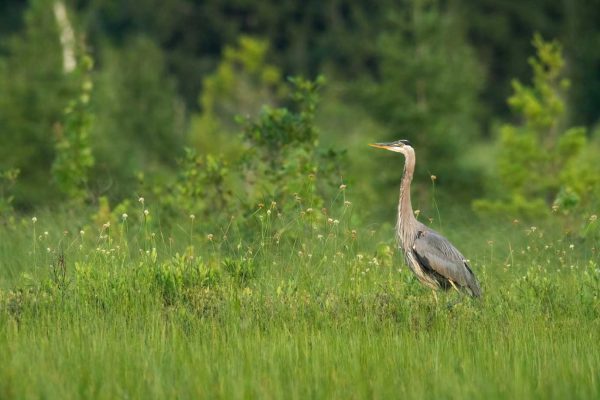
Great Blue Heron, by Nathaniel Child
Messalonskee Marsh is situated at the southwestern end of the 3,500-acre Messalonskee Lake, and provides more than 1,300 acres of emergent wetland. Cattails, pickerelweed, shrubs, grasses, and sedges are dominant plant types, and patches of irises, rose pogonia, and sundews are scattered throughout the marsh. Since the lake was dammed and the water level rose, it has become an important habitat for many water birds and was classified as a Significant Wildlife Habitat for Inland Waterfowl and Wading Birds.
Unfortunately, it is also suffering from an invasion of an exotic species: Variable milfoil, which is a relative of the highly aggressive and invasive Eurasian watermilfoil that has outcompeted native vegetation in lakes across the U.S., fills the channel below my kayak as I paddle away from the boat launch.
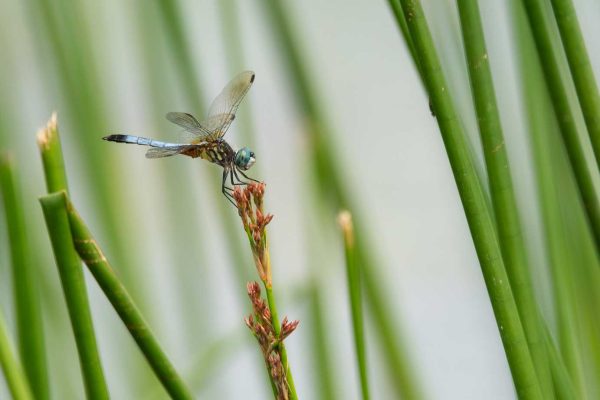
Blue Dasher dragonfly, by Nathaniel Child
As my kayak glides past patches of reeds and pickerelweed, hundreds of dragonflies dart in every direction across the water, some stopping to perch on the vegetation poking out of the water. Red-winged Blackbirds call from shrubs on either side, and a Great Blue Heron stalks prey in a shallow pool to my right. Barn and Bank Swallows swoop overhead, chittering as they pursue insects through the air. The marsh is teeming with life, and I pause my paddling for a few minutes to enjoy the calming soundscape of calling birds and buzzing insects.
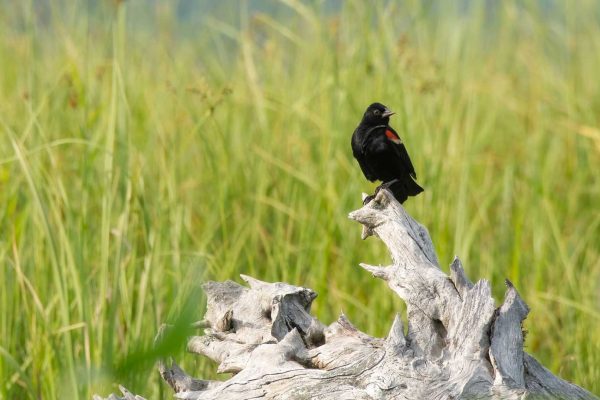
Red-winged Blackbird, by Nathaniel Child
As my kayak drifts in the slight breeze, I see a pair of birds flying low over the marsh, pausing here and there to briefly hover over the water. They make their way toward me, and I notice the black and silver feathers and long, pointed wings of the Black Terns. I pull out my camera and get my first close looks at the bird that has brought me to this marsh. Their swooping and diving flight is hard to track with my camera, but I’m able to get some good views as they fly overhead and make their way across the marsh.
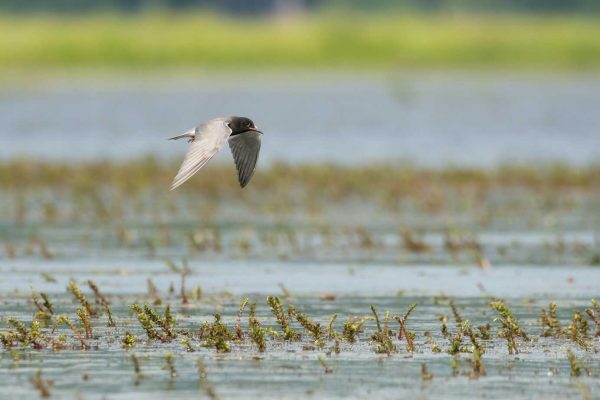
Black Tern, by Nathaniel Child
Maine’s Black Terns nest in emergent wetlands, which are characterized by vegetation that roots underwater and grows up to and out of the surface of the water. They build their nests out of reeds and sticks on small mud flats or floating mats of dead vegetation, usually near small patches of open water, often only a few inches above the water level. The terns typically nest in small colonies, generally with 3 to 15 nests in a cluster. Their social nature makes it likely to see them feeding or resting in groups throughout the breeding season.
The Black Terns become more numerous the deeper I paddle into the marsh. Red and green buoys, which mark the channel of deep water for boats, seem to be the preferred perches for the Black Terns, as each one is topped with a resting tern. It’s hard to say exactly how many terns call this area home, but at one point I see a group of about 20 rise up from the grasses and shrubs in the center of the marsh and spend a few minutes circling overhead before dispersing.
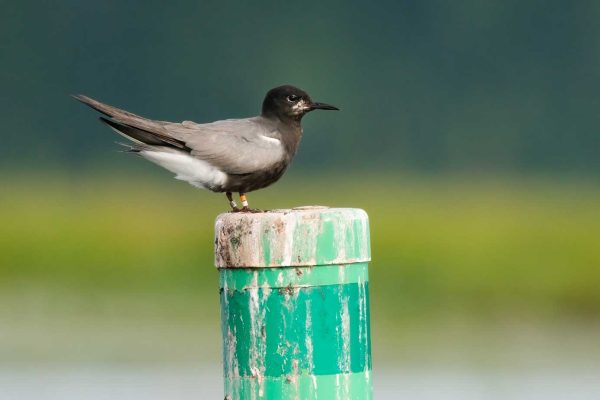
Black Tern on green channel marker, by Nathaniel Child
Soon I’ve found a spot that seems to be a popular feeding location. I stop my kayak, and within a matter of minutes witness a tern fly low over my head, hover for a few moments, then dive toward the water, snatching something off the surface. I continue watching as tern after tern glides in, dives toward the water, then swoops up again. Many of the terns are already beginning to molt out of their breeding plumage: flecks of white are visible around their faces. Before long, their plumage will be primarily white and grey, with a black dot behind their eye and gray cap, somewhat resembling a juvenile Bonaparte’s Gull.
While Black Terns will eat small fish, much of their diet in the breeding season is made up of insects. Unlike some terns, who make spectacular dives to catch fish below the surface of the water, Black Terns prefer to pluck their prey from the surface of the water and will also pursue insects through the air in a very swallow-like fashion.
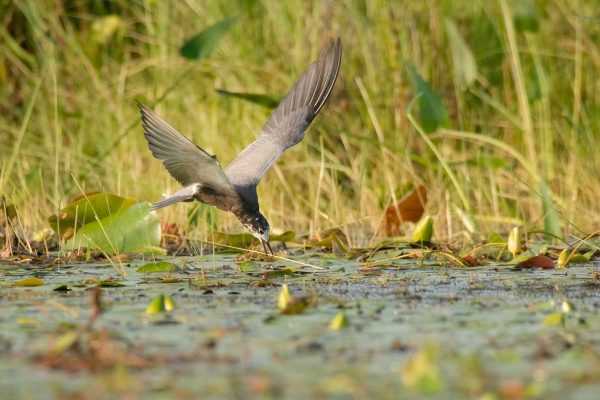
Black Tern, by Nathaniel Child
Perhaps one of the most fascinating things about Black Terns is their double lives. In contrast to their preference for freshwater marshes during the breeding season, their non-breeding season is spent in the tropics, living near the coasts of northern Central America. While there, their onshore diet will continue to include insects and other small organisms but will become almost entirely based on fish such as anchovies, sardines, and silverside minnows in offshore waters.
Black Terns were not known to be present in Maine until 1946, when the first nest was detected here at Messalonskee Marsh. It is thought they expanded their range into Maine to take advantage of marshes that were being created for waterfowl in the 1940s and 1950s.
Unfortunately, this expansion hasn’t helped their populations increase; rather, North America’s Black Tern population has declined by as much as 66 percent since the 1960s.
The exact reason for the Black Tern’s decline isn’t known, but it is likely due to a number of factors: fluctuating water levels that flood their nests, loss of breeding and wintering wetland habitat, decreased fish populations in the tropics, and a decrease in insect populations are all possible factors.
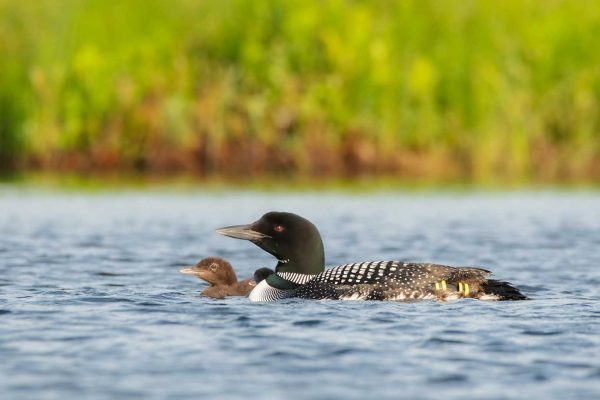
Common Loon and baby, by Nathaniel Child
After taking hundreds of images of the terns swooping and diving, I decide to paddle on to see what other birds I can find. In the distance a bittern flies low over the shrubs, but a closer look reveals it to be an American Bittern, not the state-endangered Least Bittern that also breeds in this marsh. A family of Common Loons floats in the open water, two fluffy brown juveniles trailing behind their parents, waiting for the next delivery of a tasty crayfish. A flash of movement between the pickerelweed catches my eye, and I see a tiny Pied-billed Grebe, followed by four even tinier chicks, their black and white striped heads and bright red bills contrasting with the dull brownish plumage of the adult. Suddenly a loud rattling call echoes over the marsh, and I see five Sandhill Cranes flying in formation toward me, huge in comparison to the grebes.
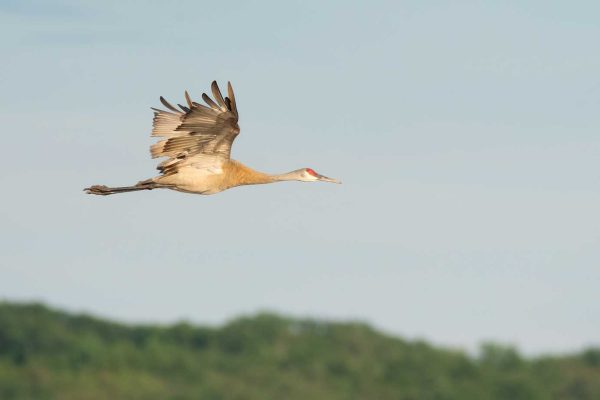
Sandhill Crane, by Nathaniel Child
As I continue to explore the marsh, I catch a glimpse of a Least Sandpiper on a small mud flat. I’m always amazed to think that these tiny birds manage to pack enough energy to fly 2,000 miles non-stop from Maine to South America into one ounce of body weight. Farther on, a trio of Greater Yellowlegs keep a watchful eye on my kayak as I paddle by. A lone Killdeer catches my eye as it walks along a sandbar, stopping occasionally to search for food. The diversity of bird life in this marsh is pretty amazing, and I feel very fortunate to have seen so many birds in such a short time.
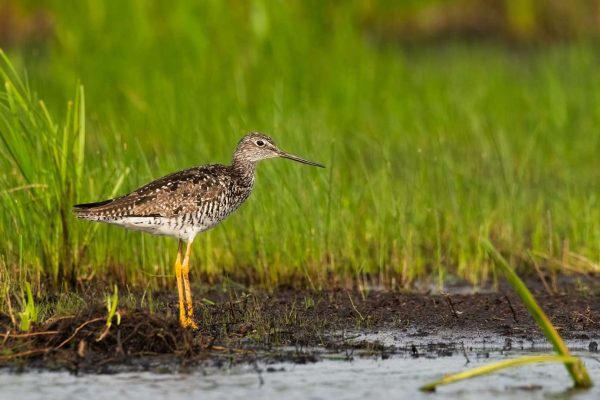
Greater Yellowlegs, by Nathaniel Child
The sun is getting low in the sky now, so I head back toward the terns to spend a little more time with them before returning to my car. Golden light illuminates their feathers as they cruise over the marsh, continuing their endless search for food. Suddenly, as if taking part in a flash mob, hundreds of swallows rise into the air into a shape-shifting mass that stretches and elongates like a murmuration of starlings. Almost as fast as it began, the group has scattered, and the swallows all begin gliding over the surface of the water, dipping down to get a drink or swooping around to catch one last insect before dark.
This short time in the Messalonskee Marsh has been both exciting and sobering. Even though the marsh looks like it’s thriving from the surface, the variable milfoil lurking below, choking out the native vegetation, reminds me that wetlands everywhere are facing difficult times. Wetland habitat across North America is in steep decline from human development, which in turn is affecting the multitude of organisms that rely on them.
It is estimated that one-third of the threatened and endangered species in the U.S. live only in wetlands, and that up to half of them use wetlands at some point in their lives. Wetlands are also incredibly important for purifying water, controlling floods, replenishing groundwater, and protecting from erosion, yet they continue to be lost to development, agriculture, and silviculture. Since colonial times, more than 50 percent of the nation’s—and 20 percent of Maine’s—wetlands have been lost. Although legislation has slowed wetland loss somewhat, our remaining wetlands are still in danger from polluted runoff, habitat fragmentation, and as I’ve seen here, invasive species.
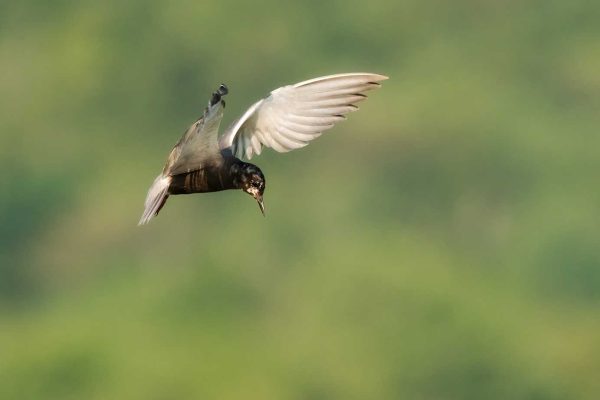
Black Tern, by Nathaniel Child
Even the birds I’ve seen today are facing challenges. The Red-winged Blackbird, which seems so common and is one of my favorite signs of spring, is suffering population declines as a result of habitat loss and persecution from farmers protecting their crops on their wintering grounds. Sandhill Cranes, which migrate through Nebraska’s Platte River in the hundreds of thousands, were once hunted to near extinction throughout much of their range, but rebounded after protections were put in place. The Endangered Species Act and Migratory Bird Treaty Act, and their protections for common as well as endangered birds, are also under attack.
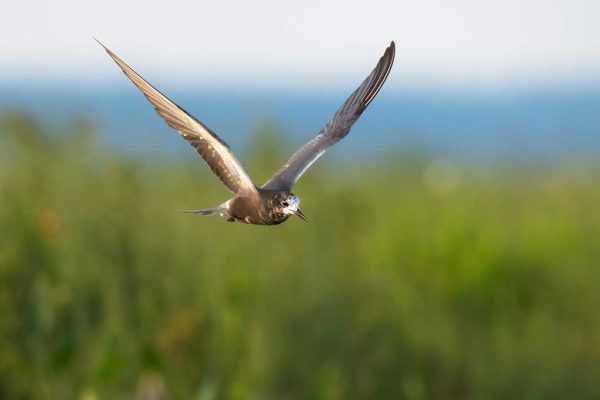
Black Tern flying across marsh, by Nathaniel Child
There are many groups and individuals working to ensure the continued protection of these special habitats, plants, and animals. The State of Maine, National Audubon, Maine Coast Heritage Trust, The Nature Conservancy, and of course the Natural Resources Council of Maine are all examples of organizations that have been working to preserve vital habitat and protect declining species in Maine.
Private landowners also play an important role, whether through conservation easements or management plans that protect the resources on their property.
With continued cooperation among groups like these on the local and national level, we might be able to create more comebacks like that of the Sandhill Cranes. With any luck, colonies of Black Terns will be an attraction for birdwatchers at Messalonskee Marsh for many years to come.
—by Nathaniel Child











Leave a Reply